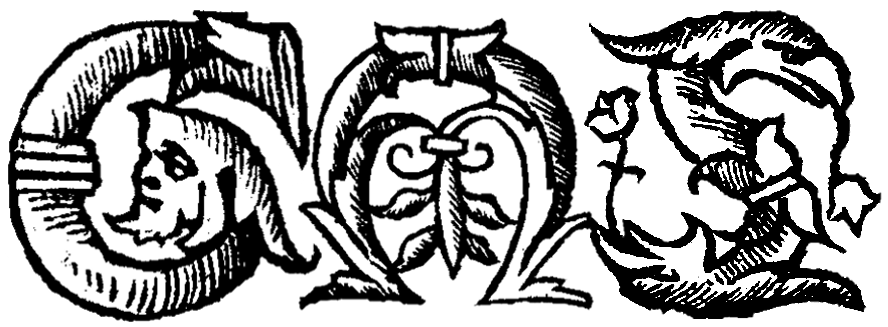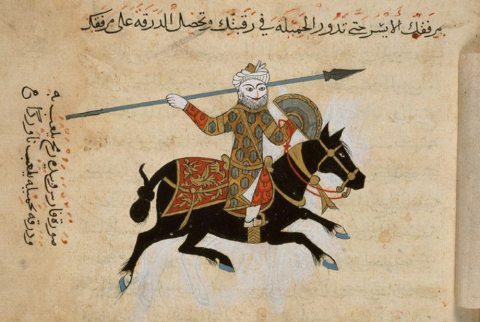"Everything's destined toward demise" | "كلُّ شيء مصيره للزوال"
Introduction to the Text
The seventh-century advent of Islam precipitated a breakthrough in historiography. In the centuries that followed the religion’s arrival, linguists, lexicographers, and chroniclers spared no effort to write all they knew of the Arabs’ pre-Islamic days, much of it preserved in verse. This poetry commemorated landmarks of the past—events not so much faithfully recorded as artistically imagined to drive home their import.
One such event, the legendary Basūs war between the sibling tribes of Taghlib and Bakr (ca.494-534), comes to us by way of several poems. They relate the following story: a forty-year war broke out with the murder of the Taghlibs’ leader, Wāʾil ibn Rabīʿah, better known as Kulayb. Not long before, Kulayb’s aunt-in-law, al-Basūs bint Munqidh, hosted Saʿd ibn Shumays as a resident under her protection. Saʿd’s she-camel, al-Sarāb, pastured with those of Jassās ibn Murrah, her nephew and Kulayb’s brother-in-law. Noticing the unfamiliar camel among his herd, Kulayb warned Jassās that al-Sarāb was not welcome to pasture near his land. Jassās responded in kind that none of his camels would pasture without her. Kulayb then threatened that if he saw the camel again, he’d stick an arrow in her breast. If he did so, said Jassās, he’d stick an arrow in Kulayb's neck. Despite this grave promise, Kulayb fatally struck al-Sarāb when he encountered her again. al-Basūs shared her humiliation with her nephew, vowing to kill Kulayb’s most prized camel, Ghilāl, in retaliation. Jassās set his mind instead to killing Kulayb, which he did.
Following Kulayb’s murder, Taghlib leadership transferred to Kulayb's brother, ʿAdiyy ibn Rab īʿah, styled “al-Muhalhil” (“The Refiner”) on account of the refinement of his poetry. al-Muhalhil maintained a killing streak for several decades, culminating in the deaths of both Jassās and his half-brother, Hammām. A third half-brother, al-Ḥārith ibn ʿUbād (or ʿAbbād), who had avoided the conflict entirely until this point, now intervened, dispatching a letter to al-Muhalhil. The message, sent with al-Ḥārith’s son, Bujayr, offered al-Muhalhil the choice of either slaying Bujayr and ending the bloodshed definitively, or releasing him to likewise establish peace. al-Muhalhil proclaimed “buʾ bi-shisʿ naʿl Kulayb!” (“Take payback for Kulayb’s shoelace!”) and slew Bujayr.
al-Ḥārith initially accepted his son’s sacrifice for the sake of peace. When he heard al-Muhalhil’s taunt, however, al-Ḥārith was incensed and decided to enter the battle, conclusively defeating the Taghlibs and capturing their leader, al-Muhalhil. Failing to recognize who he had captured, al-Ḥārith commanded his prisoner to lead him to al-Muhalhil; the latter promised to do so on the condition that he would not harm him. al-Ḥārith acquiesced. When the prisoner identified himself as al-Muhalhil, al-Ḥārith was true to his word, cutting off al-Muhalhil’s forelock (a mark of humiliation in this society) but otherwise leaving him alone.
In the following rithāʾ, or elegy, al-Ḥārith laments the disrespectful slaying of Bujayr (his son), expresses the many hard feelings he endured as a consequence, and showcases images and moods from the day of his battle against the Taghlibs. The poem is best known by its famous refrain, “Qarribā marbaṭ al-Naʿāmah minnī,” (“Bring me al-Naʿāmah’s harness”), al-Naʿāmah being his unrivaled horse. The poem as it survives exists in multiple versions, though none live up to the claims by medieval historiographers that al-Ḥārith repeated this call over fifty times. Another text featured in the Global Medieval Sourcebook, "Can you make out twilight's ruins?", comprises al-Muhalhil’s response to al-Ḥārith’s elegy. While these two poems have traditionally been ascribed, respectively, to al-Harith and al-Muhalhil themselves, more research is required to determine their precise transmission and authorship.
About this Edition
This edition is based on Cheikho, L. Kitāb Shuʿarāʾ al-Naṣrāniyyah. Vol. 1, Beirut, Maṭbaʿat al-Ābāʾ al-Mursilīn al-Yasūʿiyyīn fī Bayrūt, 1890. 271-273. For the purposes of translation, I also consulted editions by Nabawī and al-Sannūdī: Nabawī, ʿA. Dīwān Banī Bakr fī al-Jāhiliyyah. Cairo, Dār al-Zahrāʾ li-al-Nashr bi-al-Qāhirah, 1989; al-Sannūdī, Ḥ. Sharḥ Dīwān Imriʾ al-Qays. Beirut, Dār Iḥyāʾ al-ʿUlūm, 1990.
Further Reading
“al-Basūs.” Encyclopaedia of Islam. 2nd ed., 2012.
- Offers an overview of the Basus war; includes a helpful bibliography.
Khalidi, T. Arabic Historical Thought in the Classical Period. Cambridge University Press, 1994.
- Surveys how the past was conceived and recorded through the first several centuries of Islamic historical writing.
Rosenthal, F. A History of Muslim Historiography. 2nd rev. ed., Brill, 1968.
- Analyzes the period’s conceptions of and approaches toward recording the past.
Credits
Text based on Cheikho, L. 1890. Kitāb Shuʿarāʾ al-Naṣrāniyyah. Vol. 1. Beirut: Maṭbaʿat al-Ābāʾ al-Mursilīn al-Yasūʿiyyīn fī Bayrūt, pages 271-273.Translation by Sherif AbdelkarimEncoded in TEI P5 XML by Danny SmithSuggested citation: al-Ḥārith ibn ʿUbād. ""Everything's destined toward demise"." Trans. Sherif Abdelkarim. Global Medieval Sourcebook. http://sourcebook.stanford.edu/text/everythings-destined-toward-demise. Retrieved on April 19, 2024.

